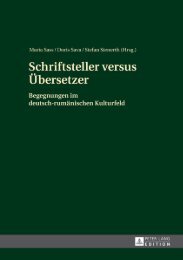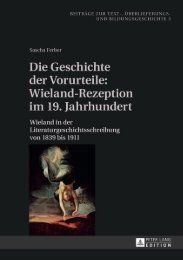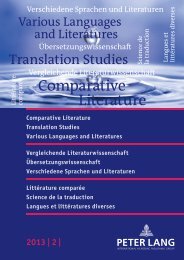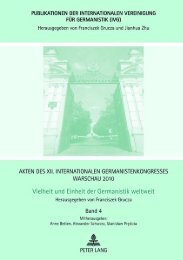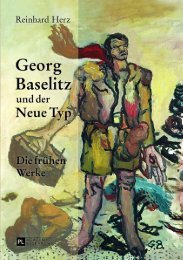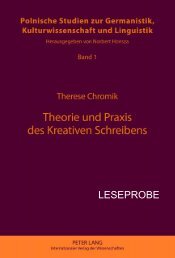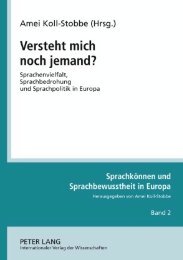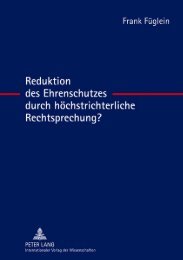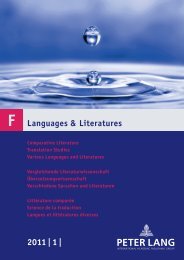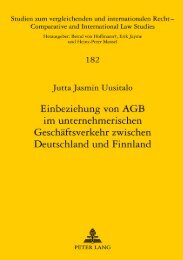Languages & Literatures 2011 | 1 | - Peter Lang
Languages & Literatures 2011 | 1 | - Peter Lang
Languages & Literatures 2011 | 1 | - Peter Lang
You also want an ePaper? Increase the reach of your titles
YUMPU automatically turns print PDFs into web optimized ePapers that Google loves.
54 Romance <strong><strong>Lang</strong>uages</strong> and <strong>Literatures</strong> · Romanistik · <strong>Lang</strong>ues et littératures romanes<br />
Ravry: A Dance of Angels and Monsters: Vic-<br />
tor Hugo’s Caducean Aesthetics • Catherine<br />
Markey: ‘Une œuvre barbare et délicate’:<br />
Hervé Guibert and the Limits of Representa-<br />
tion • Anna Magdalena Elsner: Uncanny<br />
Balbec: Crypts, Nightmares and Phantoms<br />
in ‘Les intermittences du cœur’ • Nicolas<br />
Valazza: The Flower and the Monster: On<br />
Huysmans’ Painters • Klem James: Surrealism<br />
and the Sublime or the Vertiginous Plunging<br />
into the Real • Martin Llewellyn: Neither<br />
Beast nor Man: ‘Qu’est que c’est qu’un monstre’<br />
? • Miranda Griffin: The Beastly and the<br />
Courtly in Medieval Tales of Transformation:<br />
Bisclavret, Melion and Mélusine • Ruth G .<br />
Vorstman: Diane as Beauty: Three Seventeenth-Century<br />
Examples • Jennifer Yee:<br />
The Black Maid and her Mistress in Manet<br />
and Zola • Elizabeth Lindley: The Monstrous<br />
Female: Images of Abjection in Marie NDiaye’s<br />
Hilda • Andrew Asibong: Haitian Bride<br />
of Frankenstein: Disintegrating Beauty,<br />
Monstrousness and ‘Race’ in Jacques Stephen<br />
Alexis’s ‘Chronique d’un faux-amour’ .<br />
aMaleena daMlé is Lecturer in French<br />
at Exeter College, Oxford University . Her primary<br />
research interests lie in intersections<br />
between twentieth- and twenty-first-century<br />
theory and literature, with a particular emphasis<br />
on gender and sexuality . Her doctoral<br />
thesis examined articulations of female corporeality<br />
and transformation in contemporary<br />
women’s writing in French and she has<br />
written articles on Amélie Nothomb, Ananda<br />
Devi and Marie Darrieussecq .<br />
auRélie l’hoStiS is a graduate of King’s<br />
College, Cambridge, where she completed a<br />
doctoral thesis on the contribution of French<br />
Caribbean literature to the creation of a historical<br />
consciousness in the region . Her publications<br />
include articles on the current debate<br />
around historical memory and slavery<br />
in France and the representation of Antillean<br />
traumatic history in works by Édouard Glissant<br />
and Patrick Chamoiseau .<br />
Christine Garbe / Karl Holle /<br />
Swantje Weinhold (eds .)<br />
ADORE – Teaching Struggling<br />
Adolescent Readers<br />
in European Countries<br />
Key Elements of Good Practice<br />
→ p. 10<br />
Neil Foxlee<br />
Albert Camus’s ‘The New<br />
Mediterranean Culture’<br />
A Text and its Contexts<br />
Oxford, Bern, Berlin, Bruxelles,<br />
Frankfurt am Main, New York, Wien, 2010 .<br />
XII, 337 pp .<br />
Modern French Identities . Vol . 38<br />
Edited by <strong>Peter</strong> Collier<br />
€ D includes VAT – valid for Germany · € A includes VAT – valid for Austria<br />
pb . ISBN 978-3-0343-0207-4<br />
CHF 69 .– / € D 47 .60 / € A 48 .90 / € 44 .45 /<br />
£ 40 .– / US-$ 68 .95<br />
O<br />
n 8 February 1937 the 23-year-old<br />
Albert Camus gave an inaugural lecture<br />
for a new Maison de la culture, or community<br />
arts centre, in Algiers . Entitled<br />
‘La nouvelle culture méditerranéenne’ (‘The<br />
New Mediterranean Culture’), Camus’s lecture<br />
has been interpreted in radically different<br />
ways: while some critics have dismissed<br />
it as an incoherent piece of juvenilia, others<br />
see it as key to understanding his future development<br />
as a thinker, whether as the first<br />
expression of his so-called ‘Mediterranean<br />
humanism’ or as an early indication of what<br />
is seen as his essentially colonial mentality .<br />
R<br />
Ann Frost<br />
amón del Valle-Inclán (1866-1936) was<br />
undoubtedly the most controversial<br />
literary figure of his generation . Whilst his<br />
genius was recognised by fellow writers, the<br />
reading public was slow to accept his work,<br />
and his theatre taxed directors and audiences<br />
alike . One of the harshest criticisms<br />
levelled against him concerned his use of<br />
repetition . This study shows how the reuse,<br />
recycling and development of material becomes<br />
one of the hallmarks of Valle-Inclán’s<br />
writing during the first three decades of his<br />
literary career, linking one genre with another<br />
and blurring the borders between different<br />
aesthetics . The repetition of themes<br />
and motifs, characters and stylistic devices<br />
reveals an underlying interdependence<br />
among works that on the surface appear un-<br />
These various interpretations are based<br />
on reading the text of ‘The New Mediterranean<br />
Culture’ in a single context, whether<br />
that of Camus’s life and work as a whole, of<br />
French discourses on the Mediterranean or<br />
of colonial Algeria (and French discourses on<br />
that country) . By contrast, this study argues<br />
that Camus’s lecture – and in principle any<br />
historical text – needs to be seen in a multiplicity<br />
of contexts, discursive and otherwise,<br />
if readers are to understand properly what<br />
its author was doing in writing it . Using<br />
Camus’s lecture as a case study, the book<br />
provides a detailed theoretical and practical<br />
justification of this ‘multi-contextualist’<br />
approach .<br />
neil Foxlee is a Visiting Research Fellow<br />
at Lancaster University and a lecturer at the<br />
University of Central Lancashire, where his<br />
teaching has included MA modules on Political<br />
Rhetoric and the Rhetoric of Narrative<br />
and Image . His published work includes several<br />
articles on Camus and a study of the campaign<br />
rhetoric of Barack Obama . He is also a<br />
contributor to (and co-editor of) G . McKay<br />
et al . (eds), Subcultures and New Religious<br />
Movements in Russia and East-Central Europe<br />
(<strong>Peter</strong> <strong>Lang</strong>, 2009) .<br />
The Galician Works of Ramón del Valle-Inclán<br />
Patterns of Repetition and Continuity<br />
Oxford, Bern, Berlin, Bruxelles, Frankfurt am Main, New York, Wien, 2010 .<br />
X, 231 pp .<br />
Hispanic Studies: Culture and Ideas . Vol . 43<br />
Edited by Claudio Canaparo<br />
pb . ISBN 978-3-0343-0242-5<br />
CHF 61 .– / € D 41 .60 / € A 42 .80 / € 38 .90 / £ 35 .– / US-$ 60 .95<br />
connected or even contradictory . Many of<br />
Valle-Inclán’s works have been studied in<br />
isolation, rather than as pieces of a whole .<br />
This book examines the elements that provide<br />
significant links in his writing between<br />
1889 and 1922, most of which shares the common<br />
backdrop of Galicia, and demonstrates<br />
that apparently unrelated works are part of<br />
a larger picture . Despite changes in perspective<br />
and genre, there are constants that relate<br />
individual works to those that precede<br />
and follow, creating a unifying pattern of<br />
continuity .<br />
ann FRoSt received her PhD from University<br />
College London . Since 1988 she has<br />
been an affiliated lecturer in the Department<br />
of Spanish and Portuguese at the University<br />
of Cambridge .



